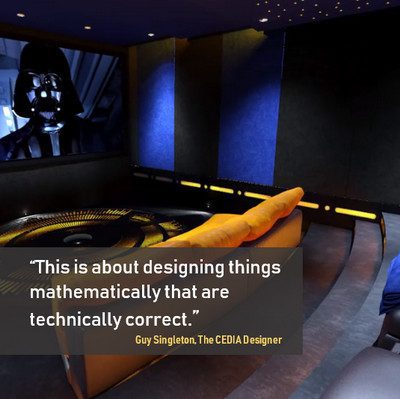When I first encountered The Cinema Designer (TCD) two years ago, I thought it was a remarkable tool for designing home cinemas.
Veteran theater designers would tell me the software, developed by UK integrator Guy Singleton, saved them oodles of time by calculating in moments what would normally take them hours or days to calculate themselves – if they even had the chops to crunch the numbers in the first place.
Who knows how to calculate reverberation in any given hypothetical room, based on the specified dimensions, surfaces and audio systems? Are you as deft with the Sabin coefficient for room acoustics as you are with pi in geometry? You don’t have to be with TCD, acquired by CEDIA earlier this year, and renamed The CEDIA Designer.
Nor do you need to perform all the math (or even hunt for the product specs) to optimize audio amplification, seating arrangements, screen dimensions and fabric, projector lenses, loudspeaker placement, and other crucial elements of a home theater.
TCD maintains a rapidly-growing database of both popular and obscure home-theater products, and the software can reconfigure a virtual room and recommend products on the fly, based on inputs from the integrator.
For example, the software melds loudspeaker sensitivities captured in the TCD database with seating distance and other room characteristics to determine the right amplification for the required SPL.
If an integrator is representing the CEDIA organization, we should expect designs based on industry-recognized home-theater standards, including CEA/CEDIA CEB-22 (audio design) and CEB-23 (video design), as well as various ITU recommendations for audio and video design.
That was the philosophy of Singleton, an experienced home-theater designer, when he began offering TCD in 2017 to his existing and future competitors – start-ups and sophisticated pros alike. He did not mind at the time that mere novices could deliver technically correct and beautifully presented home cinemas that might look (at least on paper) similar to his own.
RELATED: TCD Case Study: Home Theater Software Wins Jobs, Engages Trade Partners
“This is about designing things mathematically that are technically correct,” Singleton said last year. “If I’m designing cinemas properly, and so are they [competitors], ultimately it will be the client that gets a better deal.”
He added at the time, “I think it will change the industry – I hope it does.”
Singleton is now in an even better position to “change the industry” with TCD, now that the software is owned by CEDIA and available to members at a discounted rate.
It’s not just the dealers and their clients that benefit from TCD: “The manufacturers like it because they can feel confident that their products are being specified correctly, with appropriate products being applied to appropriate-sized rooms,” says CEDIA president and CEO Tabatha O’Connor.
As part of their association membership, CEDIA members receive a free subscription for “Media Room,” TCD’s Level I offering, a $625 value.
TCD Calculations and Output*
Audio
- 5.1 / 7.1 Legacy CODEC
- In-room floorstanding loudspeakers
- Single subwoofers
- Multiple subwoofers
- On-wall loudspeakers
- Centre On-Wall channel above/below flat panel display
- In-Wall / custom install loudspeakers
- Ceiling placement for ear-level channel loudspeakers
- Immersive CODEC up to 7.1.4
- Immersive CODEC up to 9.1.4
- Dolby Atmos enabled
- DTS:X enabled
- Auro 3D enabled
- 1st reflection points
- RT60/500 Sabine Equation
- Audio Excellence's Congard Code
- Optional additional side surround speakers (not discreet channels) per row
- Immersive CODEC up to 32/48 channels
- High channel count above 11 channels / Trinnov Whitepaper (channel count calculated by manufacturer recommendations)
- High channel count above 11 channels / Harman's JBL Synthesis SDP-75 (channel count calculated by manufacturer recommendations)
- High channel count above 11 channels / Trinnov Whitepaper (user-selected channel count)
- High channel count above 11 channels / Harman's JBL Synthesis SDP-75 (user-selected channel count)
- High channel count front-wide speaker selection
- Speaker placement table with distances from listening position in PDF
- Client PDF calibration reports
Video
- Flat panel displays (Up to 105″)
- Flat panel displays (Up to 105″) + Drop down screen
- Interactive seating configuration
- Sofa seating configuration (with/without arm rests)
- Fixed screen vertical height adjustment, sightlines and viewing angles
- Custom screen size selection
- Projector placement options (on-ceiling, pole-mounted or in-ceiling motorized lifter)
- Projector lens throw calculation
- Projector fL (foot-Lamberts) calculation
- DCI-compliant Equipment
- Screen size calculation for acoustically transparent fixed screens
- Screen size calculation for non-acoustically transparent fixed screens
- Through-wall projector placement
Seating, Acoustical Treatments, Wall Construction
- Multiple tier seating configuration
- Different front row seating configuration
- Sofa or armchair cinema seating configuration
- User-selected MLP Row (main listening position)
- User-selected seating position for screen view render
- Baffle wall construction
- Acoustic treatment
Documentation, Drawings, Dealer Tools
- Interactive room render configuration tool (color of seats, walls, carpet and screen image, plus ceiling and/or coffered lighting)
- Render configuration tool
- True-to-room renders including manufacturer's seating
- Export to MS Word Client PDF Documentation for Subscribers
- Editing a previous design (each edit is also one of your uses of the tool)
- 3D DXF of the room
- Client PDF documentation with Equipment and Technical Calculations
- CAD screengrabs of each room elevation in the PDF
- Account management / job history portal
- CSV file export to D-Tools' SI 2017
- CEDIA Whitepaper available (CEDIA members only)
*Features vary according to TCD package; all available with Cinema Room Pro.







